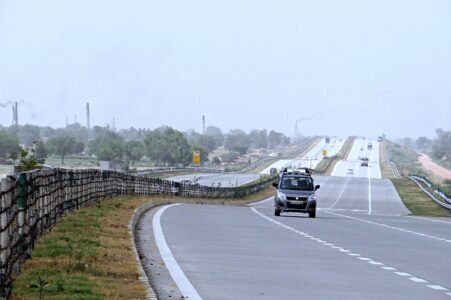Bharatmala pariyojana
Ministry of Road Transport and Highways
Context:
Projects comprising length of 1,371 km have been awarded in North Eastern States, including Assam, under Bharatmala Pariyojana Phase-I, out of which 27 km length has been completed.
Contents
About Bharatmala pariyojana:
- The Bharatmala Pariyojana is a centrally-sponsored and funded Road and Highways project of the Government of India.
- The project comes under Ministry of Road Transport and Highways
- Launched on : 31 July 2015
- The total investment for 83,677 km committed new highways is estimated at ₹5.35 lakh crore , making it the single largest outlay for a government road construction
- The project will build highways from Maharashtra, Gujarat, Rajasthan, Punjab, Haryana and then cover the entire string of Himalayan territories – Jammu and Kashmir, Himachal Pradesh, Uttarakhand – and then portions of borders of Uttar Pradesh and Bihar alongside Terai, and move to West Bengal, Sikkim, Assam, Arunachal Pradesh, and right up to the Indo-Myanmar border in Manipur and Mizoram.
- Special emphasis will be given on providing connectivity to far-flung border and rural areas including the tribal and backward areas.
- Bharatmala Project will interconnect 550 District Headquarters (from current 300) through a minimum 4-lane highway by raising the number of corridors to 50 (from current 6) and move 80% freight traffic (40% currently) to National Highways by interconnecting 24 logistics parks, 66 inter-corridors (IC) of total 8,000 km (5,000 mi), 116 feeder routes (FR) of total 7,500 km (4,700 mi) and 7 north east Multi-Modal waterway ports.
- The ambitious umbrella programme will subsume all existing Highway Projects including the flagship National Highways Development Project (NHDP), launched by the Atal Bihari Vajpayee government in 1998.
- It is both enabler and beneficiary of other key Government of India schemes, such as Sagarmala, Dedicated Freight Corridors, Industrial corridors, UDAN-RCS, BharatNet, Digital India and Make in India.
Bharatmala Pariyojana Project Components
- Economic Corridor – As per the guidelines of the road construction project, the construction of 9000kms of Economic Corridors will be undertaken by the central government.
- Feeder Route or Inter Corridor – The total length of the roads, which fall under the Feeder Route or Inter Corridor category, is a whopping 6000kms.
- National Corridor Efficiency Improvement – 5000kms of roads, constructed under the scheme will fall in the category of National Corridor for the better connection between roads.
- Border Road and International Connectivity – Connecting the cities and remote areas, which are situated in the border regions, the project has kept provision for constructing 2000kms roads that fall in the Border Road or International Connectivity category.
- Port Connectivity and Coastal Road – To connect the areas that are dotted along the shorelines and important ports, the central government has ordered the construction of 2000km of roads.
- Green Field Expressway – The main stress will be given on the construction and development of Green Field Expressway for better management of traffic and freight.
- Balance NHDP Works – Under the last segment, the project will see construction and maintenance of about 10,000kms of new roads.
Objectives Bharatmala Pariyojana:
- To optimise the efficiency of freight and passenger movement across the country by bridging critical infrastructure gaps through effective interventions.
- The effective interventions include the development of economic corridors, inter corridors and feeder routes, national corridor efficiency improvement, border and international connectivity roads, coastal and port connectivity roads and greenfield expressways.
- Economic Corridors: These are integrated networks of infrastructure within a geographical area designed to stimulate economic development.
- Greenfield Projects: They lack constraints imposed by prior work on the site. Typically, it entails development on a completely vacant site and architects start completely from scratch.
- Brownfield Projects: They carry constraints related to the current state of the site and might be contaminated or have existing structures that architects have to tear down or modify in some way before the project can move forward.
- The effective interventions include the development of economic corridors, inter corridors and feeder routes, national corridor efficiency improvement, border and international connectivity roads, coastal and port connectivity roads and greenfield expressways.
- To generate a large number of direct and indirect employment opportunities in the construction and infrastructure sector and also as part of the enhanced economic activity resulting from better road connectivity across the country.
- To connect 550 districts in the country through national highway linkages.
Features:
- Improvement in the efficiency of existing corridors through the development of Multimodal Logistics Parks and elimination of chokepoint.
- Multimodal Logistics Parks are a key policy initiative of the Government of India to improve the country’s logistics sector by lowering overall freight costs, reducing vehicular pollution and congestion, and cutting warehousing costs.
- A chokepoint is a single point through which all incoming and outgoing network traffic is funnelled and hence, leads to congestion and traffic.
- Enhance focus on improving connectivity in North East and leveraging synergies with Inland Waterways.
- Emphasis on the use of scientific and technological planning for Project Preparation and Asset Monitoring.
- Satellite mapping of corridors to identify up-gradation requirements.
- Delegation of powers to expedite project delivery for successful completion of Phase I by 2022.
What are the challenges?
- Earlier similar plans execution suffered due to problems of funding and delays in approval and execution.
- But typically, governments in the past have struggled with several operational issues such as land acquisition and other approvals.
- The big concern is funding, the plan depends more on government funding, and as much as 15 per cent of the total investment is expected from the private sector.
- Given the patchy record of public-private partnership schemes in India, there is no clarity on private sector investments.
- Big construction companies such as Larsen & Toubro, GMR and GVK have been missing from auctions for highway projects.
How the challenges can be addressed?
- To speed up the process of approvals, the government has already empowered National Highways Authority of India to approve all engineering, procurement and construction projects.
- To rope private sector in, the government need to draw a definitive road map for timely completion, fund mobilisation as well as streamline other bottlenecks in the form of land acquisition.
- To achieve dramatic changes, the government will have to improve its execution skills manifold by working closely with state governments.
- The plan should go a long way towards improving connectivity, not just to the coastal and border areas but to backward areas as well.
Source: PIB
You can find many articles on Infrastructure and Industry (part of GS III) in our website. Go through these articles share with your friends and post your views in comment section.
Discover more from Simplified UPSC
Subscribe to get the latest posts sent to your email.



